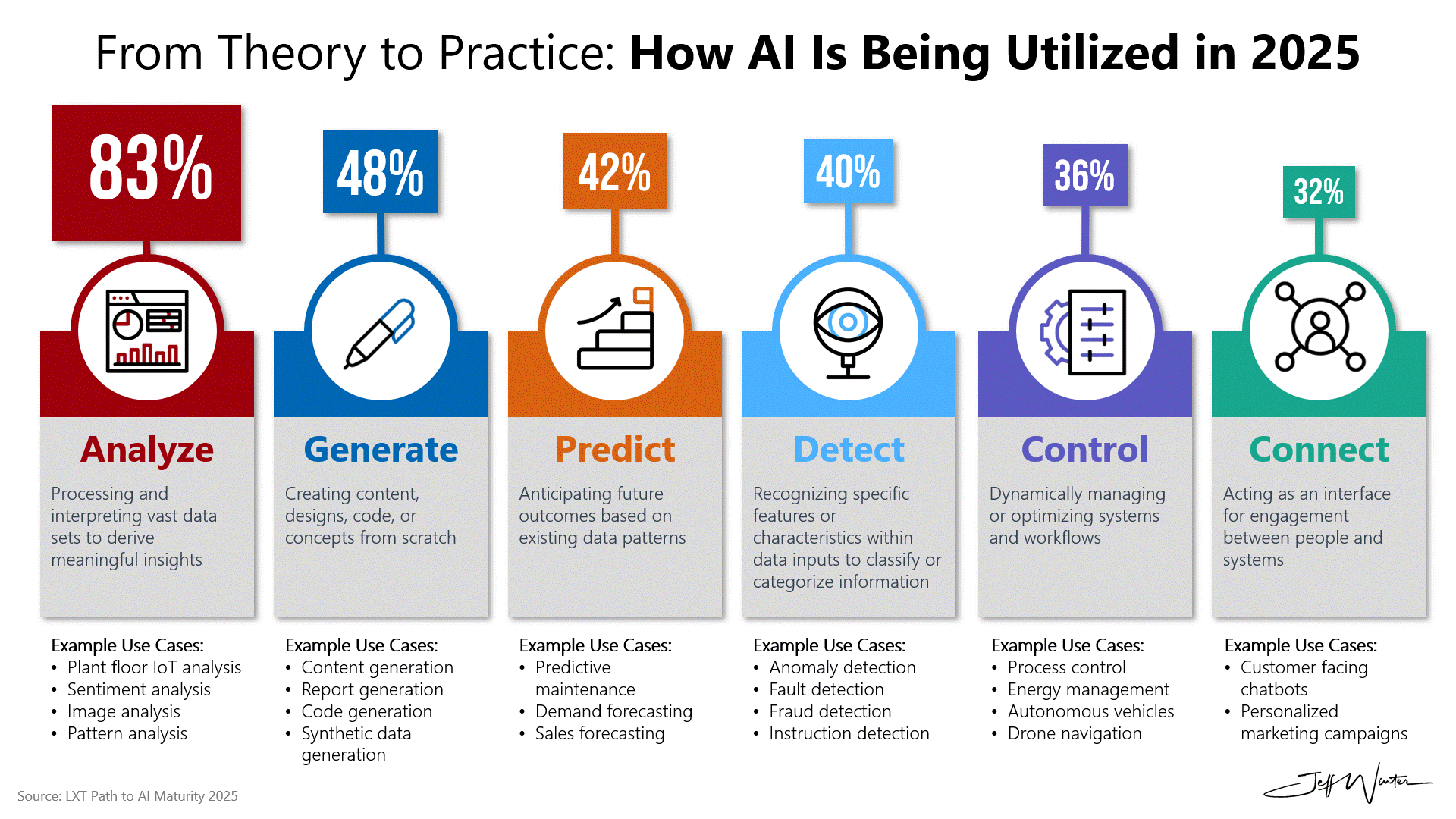From Theory to Practice: How AI Is Being Utilized in 2025
When I first introduced the six-category model of AI usage—Connect, Generate, Predict, Analyze, Detect, and Control—it was a practical framework to help business leaders understand the various ways AI could create value. LXT picked up the framework in their 2024 Path to AI Maturity report and used it to structure one of the key survey questions. That was cool enough.
But then came the 2025 report.
Same question. Same six options. Completely different results.
And that’s what makes this so interesting. In just 12 months, we’ve watched a complete reshuffling of AI priorities. "Connect"—last year’s front-runner—is now at the bottom. "Analyze" has rocketed to the top. And every other category has seen some level of shift.
You might expect gradual changes. But this? This is a system-wide reordering that reflects deeper shifts in strategy, capability, investment, and even the kinds of people weighing in on the topic.
Let’s take a look at how the responses changed—same categories, different outcomes:
Primary Uses of AI (2024 vs 2025)
Six Hypotheses for Why the Shift Happened
Strategic Mindset Shift: From Defense to Offense
In 2024, AI strategies were driven primarily by risk management. But in 2025, the top driver is technological innovation, followed closely by competitive differentiation. That change in intent reflects a broader pivot—from AI as a cost-avoidance tool to AI as a growth accelerator. It’s no surprise that "Analyze" and "Generate" are surging.
GenAI Went Mainstream—and Mature
In 2024, only 12% of companies had deployed generative AI, and it was near the bottom for ROI. By 2025? A staggering 80% of companies are using GenAI, and it’s now the highest ROI-producing AI type. That widespread adoption unlocked new use cases—especially in data analysis, which now includes summarization, document processing, and insight generation through LLMs.
Survey Demographics Changed
Here’s something easy to overlook: the profile of respondents shifted. The 2024 survey included 322 companies, while 2025 had 200—but a greater share of 2025 participants were C-suite and senior IT leaders. In 2024, only 72% of organizations were considered "Maturing" in their AI journey. In 2025, that number jumped to 83%.
This matters. Because more experienced organizations prioritize deeper operational AI—"Analyze," "Predict," and "Control"—while newer adopters are more likely to start with customer-facing tools like "Connect."
AI Budgets Got Bigger and Bolder
Spending patterns tell another story. In 2024, only 13% of organizations invested more than $50M in AI. By 2025, that figure more than doubled to 30%. The number of companies spending over $500M grew sevenfold. That surge enabled broader and more sophisticated deployments—particularly those tied to data-heavy functions like analysis and control systems.
Survey Framing and Interpretation May Have Evolved
Even when the categories stay the same, how people interpret them doesn’t. In 2025, the rise of LLM-based data analysis likely made "Analyze" feel more relevant, whereas in 2024, that same category might have sounded like glorified Excel macros. Similarly, “Connect” may have lost novelty as customer-facing AI interfaces became normalized.
AI Isn’t Just Assisting—It’s Taking Over
The rise in "Control" suggests a growing willingness to let AI act, not just analyze. As AI maturity grows, organizations shift from using AI to guide decisions to using it to make them—adjusting machine parameters, orchestrating workflows, or even balancing energy consumption in real time. That requires not just confidence in AI, but infrastructure built for autonomy.
References:
LXT - Path to AI Maturity 2024 Report: https://info.lxt.ai/the-path-to-ai-maturity-2024
LXT - Path to AI Maturity 2025 Report: https://info.lxt.ai/report-download-the-path-ai-maturity-an-executive-survey-2025
Tune in to this episode to learn more about Jeff’s take on LXT’s recently published Path to AI Maturity report, the current state of the AI evolution, and how companies can begin or further their AI and digital transformation.



